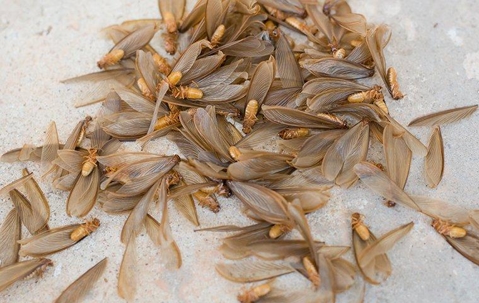This is an important time of year for residents in Columbus, Ohio. Spring is the beginning of the termite season. While termites can be active all year long and can damage Columbus homes in the dead of winter, warm air temperatures increase ground temperatures, and termites increase their activity in response to this increase in temperature. As it warms up, some colonies will start to release swarmers. If you don't know what a swarmer is or what it means to see swarmers on or inside your home, your property could be in serious jeopardy. Here's what you should know.
What is a swarmer?
A swarmer is a reproductive termite with wings. You may hear the term alate when these termites are referenced. Alate means that they have wings. It isn't a stage of development, though there is development involved. In the adult stage, all termites begin life as a worker. As needed, workers are instructed to develop into soldiers or reproductives. Some reproductives are further instructed to grow wings. This metamorphosis alters them from darkness-dwelling insects to light-seeking insects. Upon command, they exit the nest to find the light.
When they break forth into the light, they swarm together; this is why they're called swarmers. The reason for the swarm is simple: to find a mate. Once mates are selected, the swarm breaks apart, and each couple seeks a location to establish their nest.
What does it mean when swarmers appear?
You can see swarmers in a few different ways. How you see a swarmer can give you some insight into the threat you're up against.
One swarmer on your skin — If a swarmer lands on you while you're in your yard and you don't see any other swarmers, you may be seeing the start of an infestation. That swarmer and its mate (somewhere nearby) broke away from the swarm and selected your property.
A few swarmers crawling around the exterior of your home — If you see fewer than a dozen swarmers crawling around near your home, it could mean the same as having one termite land on you. But the fact that there are several termites indicates how close your home is to the nest that released those termites. So it is likely that you have a mature nest of termites close enough to your home to be already feeding on your home.
Lots of swarmers crawling on your exterior — This is a warning sign that you probably have a current and mature infestation on your property. That means it is likely that termites have damaged your home for years. But the damage may not be extensive.
A few swarmers inside your home — Termite swarmers have no reason to get into your home from the outside. If you find even one termite swarmer in your house, it is because you have worker termites creating tunnels in the wood of your home, and swarmers have emerged indoors instead of outdoors. This is a warning sign of a severe infestation. If the nest is close enough for swarmers to come out inside your home, you're in trouble.
Lots of swarmers inside your home — How many termite swarmers you see inside your home can give you an idea of how large the colony is. Eastern subterranean termites can have colonies with more than a million workers.
What does a swarmer look like?
These termites are simple to identify. They are only about ⅜ of an inch long, and most of that length is wings. Their long white wings are double their body length. So, if you see tiny black insects with long white wings that are rounded at the tips, you're looking at warmers.
What should you do when you see swarmers?
Your first response should be to contact 1st Response Pest Management. Our licensed termite control professionals use industry-leading control products to exterminate termites and eliminate colonies. Reach out to us today to talk with us about your options. We're here to help.

